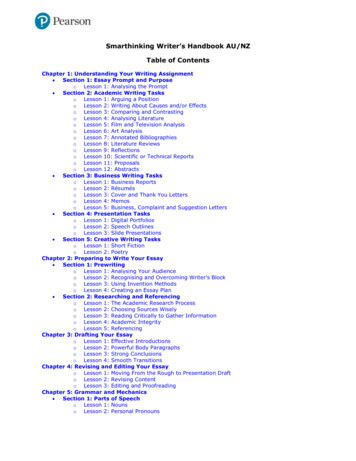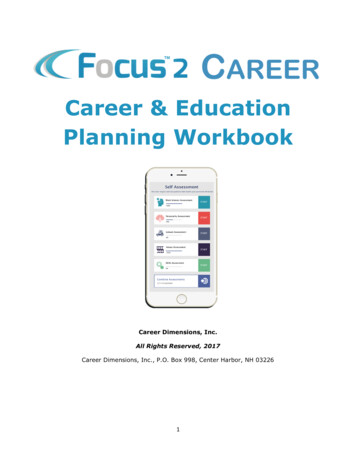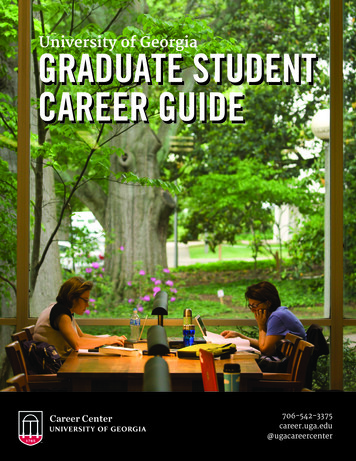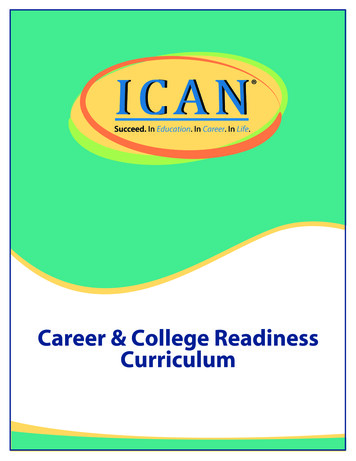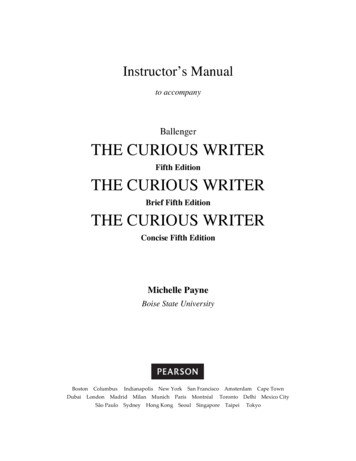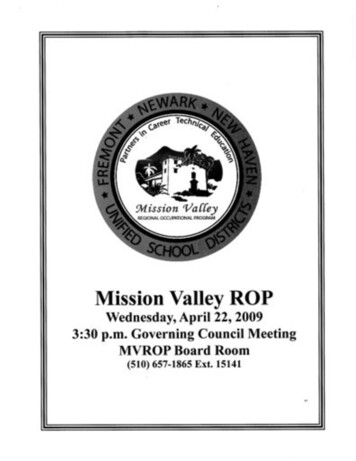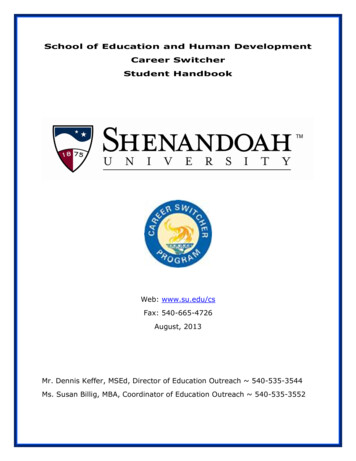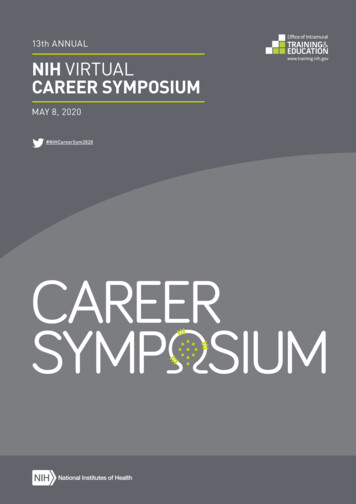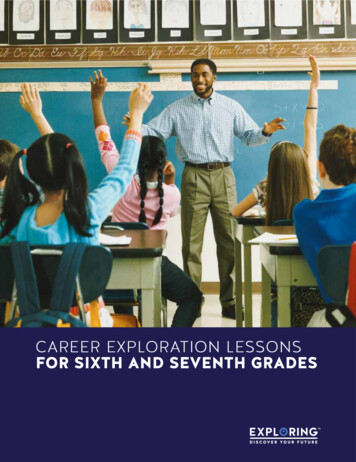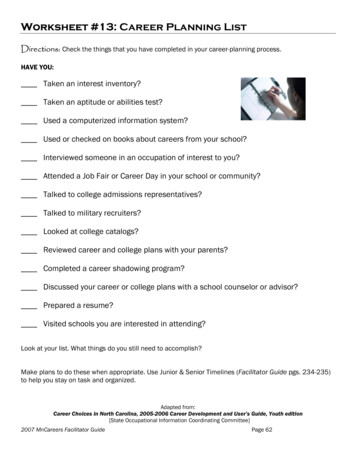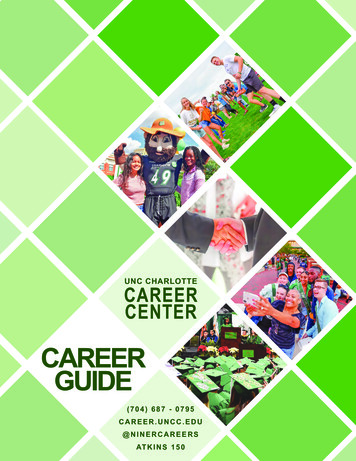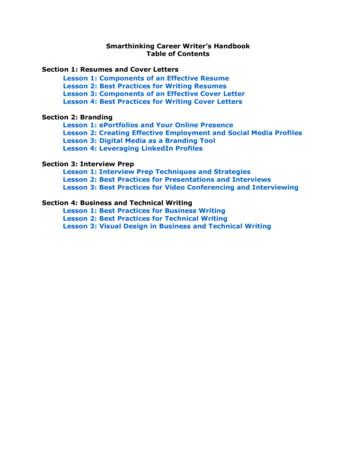
Transcription
Smarthinking Career Writer’s HandbookTable of ContentsSection 1: Resumes and Cover LettersLesson 1: Components of an Effective ResumeLesson 2: Best Practices for Writing ResumesLesson 3: Components of an Effective Cover LetterLesson 4: Best Practices for Writing Cover LettersSection 2: BrandingLesson 1: ePortfolios and Your Online PresenceLesson 2: Creating Effective Employment and Social Media ProfilesLesson 3: Digital Media as a Branding ToolLesson 4: Leveraging LinkedIn ProfilesSection 3: Interview PrepLesson 1: Interview Prep Techniques and StrategiesLesson 2: Best Practices for Presentations and InterviewsLesson 3: Best Practices for Video Conferencing and InterviewingSection 4: Business and Technical WritingLesson 1: Best Practices for Business WritingLesson 2: Best Practices for Technical WritingLesson 3: Visual Design in Business and Technical Writing
Lesson 1: Components of an Effective ResumeA resume is a potential employer’s snapshot into who you are and what you bring to a position. It’syour chance to showcase your accomplishments in an ordered and visually appealing way. Like allwriting, a resume should be written to its target audience. In fact, you may be surprised to learn thatone key to creating an effective resume is tailoring it to each different position, even if you’re applyingfor multiple positions within the same company. Your resume may not need an overhaul every time,but it should be considered as a living document that will change in response to the specific job you’reseeking. As with any piece of writing, creating an effective resume is a process.Resume ComponentsMost resumes are a single page, and their basic structure relies on the following guidelines, which aredemonstrated in the sample resume below. You can find additional sample resumes in the Appendix.Contact InformationBegin the resume with your name at the top in a large, bold font. Under your name, place yourmailing address, your professional email address, and your phone number. In this section, you canalso place a link to your LinkedIn account, ePortfolio, or professional website. See Digital Media as aBranding Tool and Leveraging Your LinkedIn Profile for tips on creating professional email addressesand using LinkedIn effectively. Also refer to ePortfolios and Your Online Presence for information onwriting and designing professional websites.SummaryThe summary should be 2-3 sentences or bullet points that describe your work experience in anengaging way. You can think of these as the focus or purpose statement for your resume. Emphasizespecific key skills and use strong verbs in this section. The Summary is also a section where you canrevise the wording for specific jobs by including keywords from the job description that match yourexperience.EducationList your degrees or certifications by starting with your most recently acquired degree. If you’re stillworking on a degree, place it first with an anticipated graduation date. If you've been on the Dean'sList, consider noting this honor along with the name of the appropriate school.Professional ExperienceThis section can have many possible titles. One strong choice is to title this section using the type ofexperience required for the potential job. For example, when you’re applying to a technical supportjob, if your work experience includes technical support and database management, you might title thissection Technical Experience or Technical Support Experience. Meanwhile, when applying for adatabase job, you might change the title to Database Experience. If you’re new to the field, considertitles like Work Experience or Professional Experience.Specialized SectionsDepending on your activities and interests, you might decide to include other special sections in yourresume to highlight skills and contributions beyond your education and specific work experience.Choose from the following possibilities: Awards: If you’ve earned awards from your academic department, your institution, orphilanthropic organizations, list them along with the dates they were received. Certifications: You may have specialized certifications related to your field. If so, place them intheir own section, identifying each certificate name and the date it was completed. If you’recurrently working on a certification, list its date with anticipated completion. Volunteer experience: Volunteer experience may be useful to include on your resume to showa potential employer your interests outside the workplace as well as your willingness to goabove and beyond required duties. Depending on how much space you have on your resume,identify the name of the volunteer position, the organization, the dates of service, and yourkey responsibilities.
Effective ResumesAs you review your resume for final editing, remember these characteristics of strong resume writing: Limit your resume to one page in most cases. Employers are busy and often have hundreds ofresumes to review for a single position. Therefore, avoid overcrowding your resume with toomany details. Save them for the cover letter or interview, and focus on including the mostapplicable and pertinent information on the resume. The only exception to this rule might be ifyou’re at a later stage in your career and need to showcase multiple application positions oryou’re completing a Curriculum Vitae (common when applying for academic positions). Be flexible by revising the resume regularly. A fresh resume will give you a fresh look at yourexperience and skills, which will translate well during your contact with the company. Use keywords from the job description. Most companies have a computer program that scansrésumés for keywords. Resumes without those keywords will be discarded before they’re everseen by a manager. Strive to omit unrelated experience. If you don’t have enough job experience in your field,then you may include unrelated work. Even so, you’ll want to keep unrelated information to aminimum and highlight skills that might transfer to the job you’re applying for, such ascustomer service skills, writing-related experience, or mastery of particular computerprograms or software specific to your field. Keep your language and tone professional. Avoid slang and text lingo, and use a professionalemail address. Refrain from including any references. You will be asked to include these later in the hiringprocess, so adding them to the resume is unnecessary and takes up valuable space.Think About It How applicable is each component to the current position?How can you showcase your skills so they directly link to this potential job?What keywords can you highlight to show you’re the best candidate?In the job application process, your resume is your chance to showcase the marketable skills that willmake you the perfect fit for the job you’re seeking. After you’ve completed your resume, use thesequestions to help keep it fresh.Return to Table of Contents
Sample ResumeMichelle chose to create aprofessional emailaddress instead of usingher usual address,catgirl08@email.com.Michelle Katz101 Amy Street St. Louis, MO 63130231-222-0123 michellekatz@emailaddressThe term fast-paced was in the jobad, so Michelle incorporated it intoher summary when she revised.SummaryProven, strong ability to manage every day and critical IT incidents in a high-stress, fast-pacedenvironment. Excellent attention to detail, enthusiastic customer service, and a strong passion forinnovation.Education2014B.S., Information TechnologyIllinois University, Coffee, IL Technical Student Excellence Award 2013 Elected President of Student Association of Sciences 2012-2014Technical ExperienceMichelleworked asa barista inhigh school,but sheomits thatto focus onrelevantwork.The job descriptionmentions a ticketingmanagement system,but Michelle doesn’tknow which one theyuse. Therefore, sheexplains that CLEO is aticketing managementsystem she’s used.June 2014 – PresentOperations Center RepresentativeComputer Operations, St. Louis, MO Manages custom database and creates new content as needed Utilizes CLEO ticketing management system to update clients and resolve issues Provides phone and email support to data hubs for everyday tasks and troubleshootingMay 2012 – May 2014IT Support HelpDeskIllinois University, Coffee, IL Managed HelpDesk to support students and professors in a computer lab with 400 devices Provided software support and projector assistance to professors in connected classrooms Provided phone and email support to all professors and students on campusVolunteer ExperienceAugust 2015 – June 2016Web DesignerIllinois University, Coffee, IL Designed the university’s new website Maintained and updated the site as neededReturn to Table of Contents
Lesson 2: Best Practices for Writing ResumesIn an ever-changing and increasingly technologically rich job market, successful resume criteria arealso in flux. While the content of your resume is critical, the presentation and philosophy behind thatcontent are increasingly important as well. You can adopt some strategies to make your resume standout from among hundreds of others and increase the chances that you’ll land an interview—andhopefully that dream job!Before WritingCreate Your BrandLike a politician or product, you can’t sell yourself as a job candidate without a platform or story. You’llneed to create a brand for use in the online job search world before you begin writing your resume.How do you want to be known? Are you an educator, a public speaker, a medical professional?Taglines and elevator speeches will help you create a brand for yourself, which will then help youframe the information on your resume. Keep these branding materials concise and use them onmultiple job-search materials: resumes, business cards, ePortfolios, and websites.TaglinesA tagline is simply a group of words that identifies you and, if repeated often enough, becomesassociated with you. Taglines are most useful in a resume summary but can be used elsewhere whendescribing job skills and experiences. For instance, if you’re an early education teacher who valueshands-on learning, you might develop a tagline like elementary school educator focusing onexperiential, kinesthetic learning. Having a consistent message will help cement your image in theminds of potential employers.Elevator PitchAn elevator pitch is a way to practice branding yourself in a short speech. Decide the top qualitiesyou’d want to share with a hiring manager or future employer. Then, compose a brief (30- to 45second) speech in which you introduce yourself, highlighting those qualities. If you happen to meetyour future boss at the elevator when arriving for an interview, how would you pitch yourself in theshort time it would take to travel to the designated floor? A prepared elevator pitch is an excellentresource not only if you really do find yourself facing a future boss at an elevator but also when you’renetworking in numerous venues, such as a career fair. Once you have your elevator pitch on paper,you can mine this brief piece for descriptions and keywords that you can use in your resume.Build and Promote Your BrandOnce your brand is in place, look for ways to increase its reach and credibility. This will ensure thatyour resume isn’t the only product out there associated with your name and credentials attached. Youcan create an ePortfolio or professional website, particularly if you have skills that are visuallymarketable, like photography. Include links to your resume, a professional picture, and a shortdescription of your career goals on the homepage. Inner pages will highlight your projects and skills.To see more, review ePortfolios and Your Online Presence.Another method for promoting your brand is to cross-list pertinent information on different documentsand social media platforms. You can include a custom LinkedIn URL on your Twitter or YouTubeaccounts as well as on business cards, your ePortfolio, and your resume. When you cross-listinformation on online platforms, you increase the chances that keywords will come up frequently whena potential employer explores who you are by entering your name in a variety of search engines.Build ConnectionsOpportunities are extremely accessible with the Internet and digital connections. While resume sitesand emails are starting points for promoting yourself, you can increase the reach of your applicationmaterials by expanding your options. Join LinkedIn and post your resume. Connect with the localChamber of Commerce to network with local business owners. Talk to family and friends. Atcorporations, obtain contact names rather than general titles. Resumes sent directly to the properchannels are 20 times more likely to be read than ones sent to the hiring manager or simply postedon a job site.
Begin WritingChoose Your FormatWhile the reverse chronological resume is an old standard, that format isn’t ideal for everyone. Acandidate with employment gaps, for example, should consider a functional resume, which focuses onskills rather than employment history.Reverse ChronologicalUsing a reverse chronological format, highlight your accomplishments by listing each position, startingwith the most recent. After identifying the employer and job title, include a handful of your mostnotable and relevant achievements and duties. A teacher, for example, might include work experienceat a previous school and prior experience at a day care. A short list of phrases describingresponsibilities, accomplishments, and skills gained would accompany each job.FunctionalThe functional format focuses on groups of skills and accomplishments. Rather than separating byemployer, these groups are separated by functions. For example, a person continuing a career inmarketing might break experience into advertising campaigns, social media marketing, and customeranalytics. Each of those categories would include responsibilities, accomplishments, and skills gainedfrom previous experience, even if they occurred at different employers.Combined FormatsA third format joins chronological and functional by listing prior employment but breakingaccomplishments into sections by function. Here, a nurse might list two previous jobs but organizeaccomplishments and duties within those jobs into functional categories like patient care,management, and nursing best practices.Choose Your StyleWhile long considered a standard font, a typical Times New Roman resume with no use of bold orother style elements could come across as unoriginal. Consider a font that is still professional but hasa bit more pop, like Calibri or Tahoma. Look for sample resumes in your industry to help you decidewhat’s appropriate and expected. Whatever font you choose, you want to make sure it’s legible andallows readers to quickly skim and understand the information being presented.You might also consider adding a bar of color to highlight important information or help your resumestand out. However, if you choose to use color, understand that the potential employer may need tomake black and white copies of your resume to share it with the entire hiring committee. If you printyour own copy in black and white before distribution, you can check to ensure the color effectstranslate well even with color removed.Most importantly, be consistent with your formatting. If your bullet points and sections don’t align,your work will raise eyebrows rather than expectations. Appearance and attention to detail count!Make them work in your favor. To see more on formatting your resume and using appropriate fonts,refer to Visual Design in Business and Technical Writing.While WritingBe PersonalRather than sending one generic resume with all applications, use a standard resume that youcustomize to suit different positions. For instance, a resume submitted for a marketing analysisposition will differ slightly from one submitted for an advertising position, even though the fields arerelated. For the marketing analysis position, an employer will want to know how you’ll obtain, analyze,and apply data results; for the advertising position, the employer’s interest shifts to the way you’ll useknowledge of customers, products, clients, and software to create effective ads, logos, andcampaigns. While both positions are technically in marketing, the contrast of analysis versus creativitymeans you’ll need to highlight your skills differently.If you find resume tweaking challenging, at the very least, be sure to create a customized, concisecover letter for each position. A prospective employer who sees the hiring manager’s name, the
company name, and a reference to a specific job posting and qualifications will be quicker to hold onto that resume than one that says your company or this position. . . But Not Too PersonalSomeone reviewing your resume doesn’t want to see personal information such as your age, religion,weight, or height. Therefore, don’t include photographs of yourself on your resume, since images canreveal or suggest these details. If you plan to model or act, this standard may not apply to you, but,for most professionals, personal details are inappropriate.Be Active and ConciseEmployers might be scanning hundreds of resumes, so those featuring multiple pages, paragraphs,and wordy, empty phrases won’t receive more than a cursory glance before being set aside. Ratherthan sentences or paragraphs, use phrases and bullet points to be active and concise. Replace wordy,passive phrases with more active phrases:Passiveresponsible for managinghad the opportunity to organize a trade showActivemanaged a team of 20 employeesorganized a trade showBe Honest. Be Perfect. Be Perfectly Honest.It seems obvious, but sometimes resume writers are dishonest when promoting themselves.Exaggeration becomes half-truth or complete fiction. Some employers will notice these inaccuracies onresumes. Those who don’t will definitely pick up on exaggerations during an interview. Save your timeand maintain your integrity. Be confident—but also be accurate and honest.Polish by ProofreadingYou only have one opportunity to make a first impression. When that impression is being made onpaper or being scanned by computers, a spelling or typographical error can make the differencebetween your resume being thoroughly reviewed or tossed in the trash. Employers want candidateswho possess an attention to detail and ability to communicate. A poorly worded resume with spellingand grammatical errors suggests that you’re unable to communicate clearly or unwilling to take theextra step to make a clean presentation. Neither are appealing qualities in a job candidate.Follow upA few days after sending your resume, contact the appropriate person to follow up. If possible, directlycontact your potential supervisor; avoid human resources personnel who are already handling a highvolume of resumes and requests for hiring updates. If you’re applying for a sales position, find thename of the sales manager before you call. Then, ask for that person directly. Plan what you mightsay or ask ahead of time, and be sure to confirm your availability and interest in the position.If making a call isn’t possible, there are many other ways to demonstrate your interest in the position.A hand-written note, typed letter, or email to a specific contact person will put your name in the mindsof those with influence in the hiring process.While many candidates feel pushy following up, doing so can move your resume out of that growingpile and in front of the right set of eyes. Follow up may be the difference between landing an interviewor being completely overlooked.Be Organized and FlexibleKeep track of your contacts. Where did you send resumes and when? What is your response rate? Ifyou’re only securing a handful of interviews but have sent out hundreds of resumes, try re-evaluatingyour resume and strategy. A new approach or strategy may be what lands you the interview—and thejob! Seek advice from tutoring services by submitting your resume for review or working with atutor in a live chat, whiteboard setting. Tailor your content more specifically to each position. Change your resume format to give it a fresh design. Take a course or volunteer to increase your marketability.
Think About It What are the best ways to create and promote your personal brand?What information should you include to best present your skills accurately and honestly?How and when should you follow up with employers to demonstrate your interest in the job?Through some legwork and attention to detail, most applicants can expect to land that coveted job, ifnot an entry-level position with the opportunity to advance. Keep this advice in mind, and hopefullyyou’ll be sorting through your wardrobe and practicing interview techniques and responses soon!Return to Table of Contents
Lesson 3: Components of an Effective Cover LetterYou might have polished your resume, but there’s another essential element in a solid job application:the cover letter. The cover letter is sent to the employer with your initial application and resume,tailored to the employer and specific position. It also highlights unique skills from your resume byproviding specific details about your accomplishments, both at former positions and throughout youreducation.The Purpose of a Cover LetterThe cover letter is a writing and a thinking document. Therefore, it has a dual purpose: todemonstrate your writing ability while showing potential employers your ability to think critically aboutand link your experiences to a given position. A cover letter is an argument you make to yourpotential employer; it’s your opportunity to make a case for how your talents match the job. Becausethe cover letter makes an argument about you as a job candidate, it should have a main claim andevidence to support those claims.A cover letter should be addressed to the individual in charge of hiring, using only his or her lastname. If you don’t know this person’s name, use his or her job title, such as Dear Managing Editor orDear Human Resources Director. Additionally, your cover letter should be only one page consisting ofthree (sometimes four) paragraphs. To organize it, use an introduction, a body, and a conclusion.IntroductionThis first paragraph should state the position and indicate why you’re interested. Mention where yousaw the job posting, including the names of any contacts you have at the company or organization,especially if someone referred you to the job. Think about answering these core questions in yourintroduction: Why are you interested in the position? Who did you talk to? What skills and experiences do you bring that make you a good fit for the position?Think of your answer to the last question as your main claim. It’s okay to write your letter in itsentirety and then go back to craft your claim. Some writers find that drafting a claim aboutthemselves before they’ve written specific examples in the body paragraphs is difficult. For help withyour claim, look at the job description’s keywords and take note of the elements of the position thatare highlighted the most. Are there repeated keywords or phrases? Your claim should include thosekeywords and phrases, indicating how the elements they’re looking for match your skills andexperiences.BodyWhatever your main claim, you want to ensure that it’s supported by your evidence. While the firstparagraph tells the potential employer why you’re a good fit for the position, one or two bodyparagraphs will show why using specific examples. These may be examples of specific projects,milestones, or accomplishments from your other jobs or more elaborate information about the type ofwork you did at a specific job or internship. Avoid simply repeating information from your resume;build on identified educational and work experiences by pinpointing specifics and elaborating on themto show the reader what you’ve accomplished: Draft: After obtaining my degree, I worked at Global University for one year as a financial aidcounselor. Revision: At Global University, I built my customer service skills while working with studentsand was recognized for Outstanding Service to Students three semesters in a row.Show what you’ve gained, learned, or accomplished from the education and job experiences includedon your resume instead of simply repeating them. To help generate a list of these benefits, sit downwith your resume and write some specific accomplishments or projects from each work-relatedposition or educational stage. You don’t need to discuss each point in detail while brainstorming;instead, once you’ve jotted down a number of ideas, you can then narrow the list and use only theevidence that clearly supports this claim.
ConclusionIncluding the following elements in the conclusion will show you’re seriously pursuing the position andcommitted to working for the company: End the cover letter by looking to the future and expressing your desired outcome, such as aninterview or a request to speak with a manager about other opportunities. Thank the employer for considering your request or application. Have a firm plan for when and how you’ll follow up on your application, letting the employerknow when to expect a call or email from you. Choose a respectful closing, such as Sincerely or Best regards.Think About It What argument or claim are you making about yourself as a potential employee in your letter?How does your cover letter complement your resume and vice versa?What specific accomplishments or positions on your resume do you want to highlight in yourcover letter?What should you include in the conclusion to note your outcome and how you’ll follow up?By writing a brief, specific cover letter with a main claim and supporting evidence from yourexperiences, you will make a positive impression and land your interview!Return to Table of Contents
Lesson 4: Best Practices for Writing Cover LettersThe job search and application process can be time-consuming, but planning can make the processmore efficient, especially when you sit down to write each of your cover letters. That’s right—you wantto tailor each cover letter to the specific position and company, so you should avoid writing onegeneric cover letter. With the right tools, though, writing a cover letter can be a truly rewardingprocess.Set Aside Time to WriteTreat the process of writing a cover letter like other tasks by setting aside a block of time to write.Review the application deadline to determine how much time you’ll have to work on your materials.You may want to earmark time to write daily or weekly, depending on the deadline. Attempt to turn inyour application before the final due date to allow time for soliciting feedback. You might useSmarthinking’s Career Writing subjects and choose either Submit My Writing for a full review orConnect with a Tutor Now for a one-on-one coaching session. If you’re submitting an electronicapplication, plan to send it early in case there are any technological glitches.Do Your ResearchFor an academic assignment, writers often gather information through research, and writing coverletters is no different. Therefore, build time into your writing schedule to research the company ororganization. Look at its website and read about its mission, vision, philosophy, or similar informationregarding what the company represents and believes. Ask yourself these questions to locate the kindof information you’ll need: What important initiatives is the company leading in the community or within theorganization? What keywords are repeated across the company’s website, social media platforms, or othercompany literature, such as brochures, pamphlets, or flyers? Who are the current employees, and what are their backgrounds? What similarities or differences do you see when comparing your professional background tocurrent employees?Answers to these questions will reveal how you as a candidate match the company and the position.At this stage, if you can find out who the hiring manager will be (the person reviewing yourapplication), make a note to address your letter specifically to that person.Draft Your Cover LetterElaborate Rather Than RepeatNo one wants to read the same information on your cover letter that’s also on your resume. Instead ofparaphrasing or summarizing information from your resume, expand by providing examples of specificprojects, milestones, or accomplishments from the job responsibilities or academic accomplishmentsyou’ve listed. You might also elaborate on experiences you had at specific points in your occupationalor academic career. Then your cover letter will complement your resume instead of simply repeatingit. For details about providing specifics in your letter, see Components of an Effective Cover Letter.Format AppropriatelyUse letter formatting, and address your letter to the hiring manager. Your address should be listed inthe first block of the letter, followed by the date and a blank line space. In the next block, list thehiring manager’s name, his or her title, and the company’s name and address. Then, after a blank linespace, begin with the greeting:222 Monterey DriveMonterey, CA 93940September 5, 2017John WatersDirector of CommunicationsWaters Communications100 Munras DriveMonterey, CA 93940Dear Mr. Waters:
Use Keywords and PhrasesReview your research notes to see important points you gathered about your potential employer. Useyour research to incorporate terms, keywords, and phrases from the company’s mission and the jobposting. Connect these keywords and phrases to your own experiences, showing how you meet notonly the qualifications but also the company’s culture and ideals.Revise Your Cover LetterSolicit FeedbackYou might seek a professional in your field or even a peer who works or has worked a similar job toask for feedback on your cover letter. Share the job posting and ask the professional or peer toidentify how well you’ll fit the job based on you
Sep 05, 2017 · Smarthinking Career Writer’s Handbook. Table of Contents . Section 1: Resumes. and Cover Letters Lesson 1: Components of an Effective . Resume. Lesson 2: Best Practices for Writing . Resumes. Lesson 3: Components of an Effective Cover Letter Lesson 4: Best Practices for Writing Cover Le
